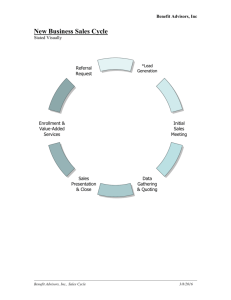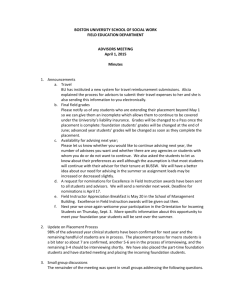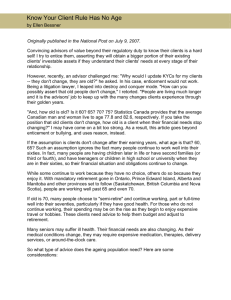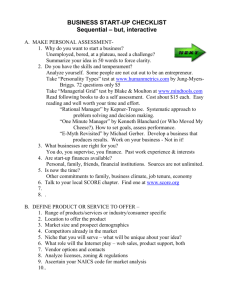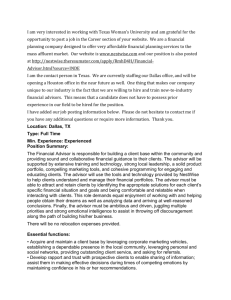Relational Aspects of Advising - Rosen College of Hospitality
advertisement
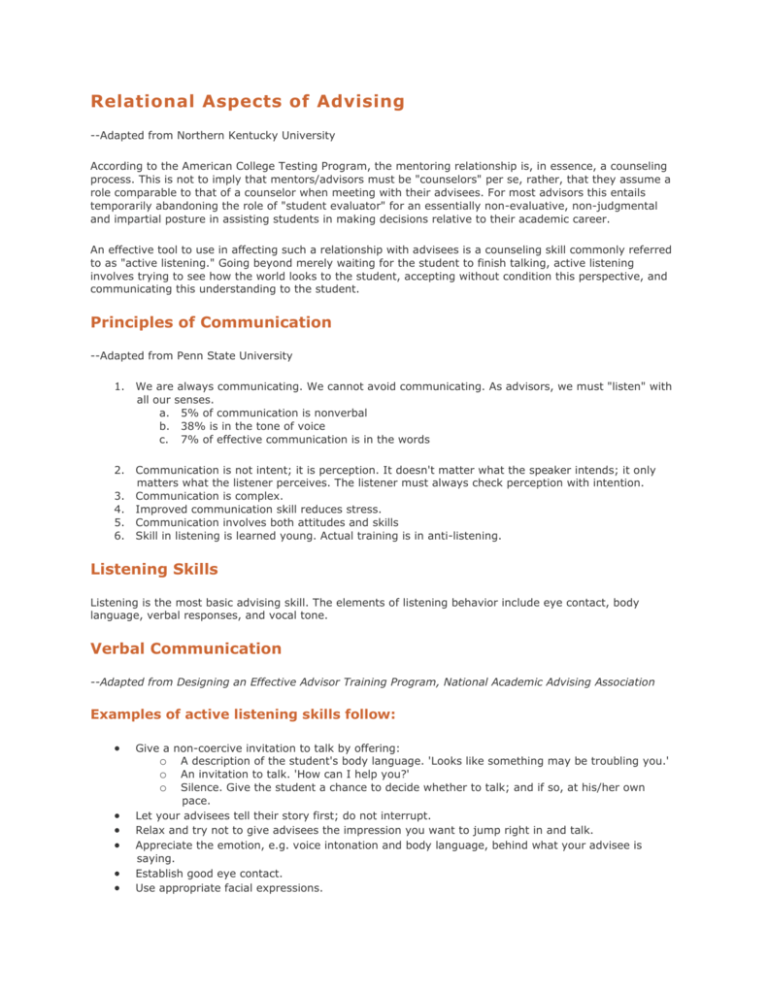
Relational Aspects of Advising --Adapted from Northern Kentucky University According to the American College Testing Program, the mentoring relationship is, in essence, a counseling process. This is not to imply that mentors/advisors must be "counselors" per se, rather, that they assume a role comparable to that of a counselor when meeting with their advisees. For most advisors this entails temporarily abandoning the role of "student evaluator" for an essentially non-evaluative, non-judgmental and impartial posture in assisting students in making decisions relative to their academic career. An effective tool to use in affecting such a relationship with advisees is a counseling skill commonly referred to as "active listening." Going beyond merely waiting for the student to finish talking, active listening involves trying to see how the world looks to the student, accepting without condition this perspective, and communicating this understanding to the student. Principles of Communication --Adapted from Penn State University 1. We are always communicating. We cannot avoid communicating. As advisors, we must "listen" with all our senses. a. 5% of communication is nonverbal b. 38% is in the tone of voice c. 7% of effective communication is in the words 2. Communication is not intent; it is perception. It doesn't matter what the speaker intends; it only matters what the listener perceives. The listener must always check perception with intention. Communication is complex. Improved communication skill reduces stress. Communication involves both attitudes and skills Skill in listening is learned young. Actual training is in anti-listening. 3. 4. 5. 6. Listening Skills Listening is the most basic advising skill. The elements of listening behavior include eye contact, body language, verbal responses, and vocal tone. Verbal Communication --Adapted from Designing an Effective Advisor Training Program, National Academic Advising Association Examples of active listening skills follow: Give a non-coercive invitation to talk by offering: o A description of the student's body language. 'Looks like something may be troubling you.' o An invitation to talk. 'How can I help you?' o Silence. Give the student a chance to decide whether to talk; and if so, at his/her own pace. Let your advisees tell their story first; do not interrupt. Relax and try not to give advisees the impression you want to jump right in and talk. Appreciate the emotion, e.g. voice intonation and body language, behind what your advisee is saying. Establish good eye contact. Use appropriate facial expressions. Use affirmative head nods. Avoid nervous or bored gestures. Fight off external distractions. Constantly check your understanding of what you hear, by restating or paraphrasing what your advisee has said. Clarifying will help your advisee understand what he/she is actually saying. Intermittently respond to your advisees with "uh-huh", "yes", "I see". Ask open-ended clarifying or continuing questions to demonstrate to your advisees that you are involved in what they are saying. Avoid inserting value judgments, lecturing, criticizing, or rejecting the feelings or beliefs of the student. Remain impartial and allow students to arrive at a solution by themselves; by clarifying, not directing, their thoughts and feelings. Constantly check to see if your advisees want to comment or respond to what you have said. Take notes regarding facts and data. Non-Verbal Communication --Adapted from Northern Kentucky University & Penn State University One's physical presentation while meeting with a student greatly determines the degree to which an authentic rapport can be established. Posture and facial expressions can easily relate that an advisor is more attentive to the day's paperwork than to the students coming for assistance. Examples of positive nonverbal communication follow: Rise and greet the student as he/she enters the office. Remove physical barriers by positioning your chair away from your desk so that you are facing the student. Place your arms and legs comfortably so you appear relaxed and open to communicate. Leaning slightly forward in your chair, without exaggeration, serves to underscore your appearing interested in what the student has to say. Maintain eye contact with the student through your conversation. Use appropriate body motions. Move in response to the speaker. Avoid nervous or distracting gestures. At the meeting's end, rise and accompany the student to the door as he/she leaves your office. Helping Skills --Adapted from Helping and Human Relations: A Brief Guide for Training Lay Helpers Goals of Helping The first goal of helping is to get the advisees to explore their problems. Advisors cannot help students unless they first understand the students' problems. All too often, we give advice before fully understanding the problem. Since this advice is not based upon the necessary understanding, it may or may not be helpful and appropriate. Sometimes students come to us and present a problem that is not the real concern. They are testing us. If we cannot sense that there is something more, they will not share the real problem with us. This sharing of the real problem is the first goal of helping. When students explore themselves, they help us to understand their problems better. The second goal of helping is to get the students to understand themselves. The students' exploration of their problems does not necessarily mean that they understand them as well as they should. Sometimes they don't understand them at all and only share them in bits and pieces. It is the job of the advisors to put these bits and pieces together in such a way that they can help the students understand the problems more fully. The final goal of helping is to get the advisees to act upon their understanding. As students understand their problems more fully, they will see more clearly the options that are available to them. Together advisors and advisees can consider the short-term and long-term advantages of each option. Students can choose the best option and work with their advisors to develop ways of accomplishing their goals. If the students act successfully, they come closer to dealing with the problem that led them to seek help in the first place. The goals of exploration, understanding, and action are related to each other. After the students have acted upon their understanding of the problem, they experience the consequences of their actions; i.e. they learn new things. The students begin to explore and understand more about themselves and their problems. As they understand more of themselves, they prepare to act once again in a way somewhat different from the way they acted before. Again, there is new learning that comes from their actions. Often the cycle of exploration, understanding, and action is repeated over and over again. Fundamentals of Helping Advisors are most effective when giving their full attention to students, doing all that they can to listen and let the student know that they understand what the student is really saying. There are a number of things that advisors can do in order to respond effectively. These are known as the following facilitative conditions: Empathy or Understanding: Understanding or empathy is the ability to see the world through the other person's eyes. In helping, it's as if the advisor crawls inside the students' world to experience the world what the student's situation the same way the student is experiencing it. The advisors not only see things the way the students see things, they communicate what they see to the students. Respect of Caring: Respect is the ability to respond to others in such a way as to let them know you care for them and you believe in their ability to do something about their problems in life. At the very beginning of helping, the advisors may not know enough about the students to communicate this specifically. As the relationships develop, the advisors will come to know the students in specific ways so that they can communicate this respect to the students directly and specifically. Concreteness or Being Specific: Concreteness is the ability to enable others to be specific about the feelings and experiences they are talking about. The advisors help the students to be specific about the students' own experiences and not the experiences of other people. This is critical during the early stages of helping when concreteness helps to develop empathy.> Genuineness: Genuineness is the ability to be real in a relationship with another person, i.e. be yourself. Confrontation: Part of being real is to tell the other person just like it is. Confrontation is telling the students what the advisors have been hearing as the advisors listen to the students. Once you confront the students, you must follow though and work out the differences between you. Immediacy: Immediacy is the ability to understand different feelings and experiences that are going on between the advisor and students. Often students have difficulty directly expressing how they feel. The advisors must be tuned in so that they can understand the students. The advisors must tell the students what is going on so that the students can understand themselves. The advisors must know where the students are coming from. Referral Skills The most important aspect of making referrals is realizing your specific area of expertise and knowing the resources available on campus, where other professionals with different areas of expertise are available to assist students. It is the responsibility of the academic advisor to get the student the best help available. When students are having difficulty or are in crisis, it is imperative not to assume that they can handle it, or that they will find their way to the proper services, on their own. If you are concerned about a student but are uncertain about the appropriateness of a referral, consult with the appropriate person in the office you are referring the student to. Tips for Getting Students to Follow Through on Referrals --Adapted from Roundy, Jack. "Tips On Making Effective Referrals In Academic Advising." Academic Advising News, Vol. XIV, No. 2, April 1992, 2, 10 In academic advising we depend a great deal on faculty and staff in other departments to help us serve our advisees. But we also know the frustration of trying to help students make effective contacts in other departments and seeing our attempts fail. Here is a set of tips on making effective referrals, tips that can result in a higher success rate in this area: Inform yourself of campus resources thoroughly, paying particular attention to the names of contact people and the chain of command in various offices. Keep a list of names, offices, and telephone numbers at hand for quick reference. When talking with students, pay particular attention to their expressed and implied referral. Students are often uneasy about following through with a referral. Try to make them comfortable with the idea, pointing out the friendliness, accessibility, and helpfulness of the people you are sending them to. This task can be crucial in the case of faculty and upper-level administrator referees, since students often find these people intimidating. Try to keep the chain of referrals as simple as possible. Often students will have to visit several offices to complete referral procedures. Help students reduce the run around by finding ways to eliminate steps. Also, work out with students a proper sequence of steps, so that they don't have to backtrack to accomplish their goals. Help students draw up agendas for referrals. Have them jot down crucial questions and procedures for getting the most of their visits with the people to whom you send them. Facilitate referrals by telephoning the parties to whom you are sending students while those students are with you. Telephoning can be helpful in two ways; it can help you to be sure that you are sending students to the right people for help, and it can give you the opportunity to make an appointment for the students on the spot, which will dramatically improve the contact rate for referrals. In fact, a good strategy for referrals is to make telephone calls and then hand the receiver to your students, encouraging them to set up appointments themselves. When you make referrals, jot down notes in your advising files that will remind you to ask students on their next visit about the results of their contacts. If students report that they haven't followed through, find out why not, and discuss the reasons. See if you should make a different referral, or if you need to become more involved in ensuring contact. Don't take the process over from your students, however, since it is their responsibility to see that their needs are met. Check your records every so often to get a sense of the referrals you have made. Student development is an ongoing process, and patterns of need and growth can be observed in the sequence of referrals you have made. Need for further direction can often be discovered in the referrals you have already made. How to Identify and Refer Troubled Students --Adapted from Northern Kentucky University University students often encounter a great deal of stress during the course of their academic experience. While most students cope successfully with the challenges that the years bring, an increasing number find that the various pressures of life are unbearable or unmanageable. As academic advisors, you often encounter these distressed students in your offices or classrooms. Many of these students have not sought any help. Thus, your role is crucial in identifying and referring students who are distressed. While many advisors are Licensed Professional Counselors, the counselors in the Counseling Center work with troubled students on a daily basis and are therefore much better prepared to assist students in crisis. The following are possible signs and emotional symptoms of distress that may indicate a serious problem: Excessive procrastination and poorly prepared work especially if this is inconsistent with previous work. Infrequent class attendance with little or no work completed. Inability to make decisions despite your repeated attempts to clarify and encourage. Listlessness, lack of energy or falling asleep in class. Marked changes in personal hygiene. Dramatic weight loss or gain. Frequent illnesses. Repeated requests for special considerations, e.g. deadline extensions. Impaired speech or garbled, disjointed thoughts. Behavior that regularly interferes with effective management of your class. High levels of irritability, including unruly, aggressive, violent or abrasive behavior. Mood swings or normal emotions that are displayed to an extreme degree or for prolonged period of time, e.g. fearfulness, tearfulness, or nervousness. Dependency, e.g. the student who hangs around you, or makes excessive appointments to see you during office hours. Lack of close friends or withdrawing from friends and/or family. Overtly suicidal thoughts, e.g. referring to suicide as an option, feelings of hopelessness, a severe loss or threat of loss, feelings of isolation or alienation, history of previous suicide attempts, or history of alcohol/drug abuse. Suicide is the second leading cause of death among college students. Eighty percent of those planning to commit suicide give warning of their intent. Homicidal threats. Bizarre or strange behavior that is inappropriate to the situation. Guidelines for referring a troubled student: Talk to the student in private. Listen carefully. Show concern and interest. Repeat back the essence of what the student has told you. Avoid criticizing or sounding judgmental. Let the student know that you want him/her to have the best help available, and that you are unable to offer the assistance they need. Students experiencing suicidal behavior, or threatening to harm others, must be taken seriously. Let the student know that you have a legal obligation to get them help, and cannot keep this information confidential. These students should be escorted to the Counseling Center by the advisor. If a student in this situation refuses to go to the Counseling Center, the advisor must notify the Dean of Students and Campus Police immediately to arrange notification of the student's family, or intended victim, and discuss possible hospitalization of the student.
